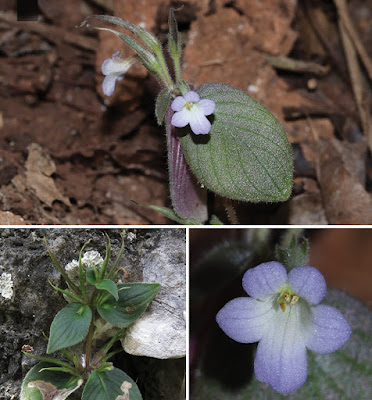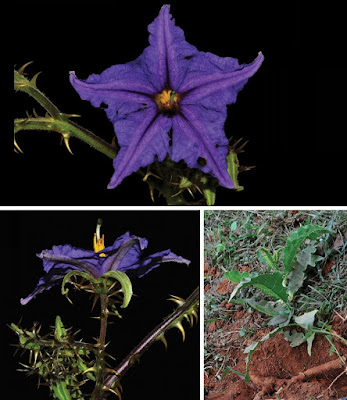[Most Recent Entries] [Calendar View]
Saturday, March 9th, 2019
| Time | Event | ||||||
| 8:01a | [Botany • 2019] Microchirita hairulii (Gesneriaceae) • A New Species from Perlis, Peninsular Malaysia
Abstract A new species, Microchirita hairulii Rafidah (Gesneriaceae) from limestone hills in Perlis, Peninsular Malaysia, is described and illustrated. Diagnostic characters, description, detailed illustrations, geographical distribution, regional provisional conservation status assessment (Endangered) and ecological observations of the new taxon, as well as an updated key to Microchirita species in Peninsular Malaysia, are provided. Keywords: conservation, flora, limestone, Malaysia, taxonomy
Microchirita hairulii Rafidah, sp. nov. Diagnosis: Microchirita hairulii most closely resembles M. caliginosa and M. sericea in having a branched stem, pale purple corolla and hairy capsule. This new species differs in having ovate leaves (vs elliptic to narrowly elliptic in M. caliginosa and M. sericea or sometimes narrowly ovate in M. sericea), serrate leaf margin (vs serrulate in M. caliginosa and M. sericea), 5–10 mm long corolla tube (vs 24–55 mm long in M. caliginosa and 10–26 mm long in M. sericea), glabrous anthers (vs hairy in M. caliginosa and M. sericea) and the seed without papillate surfaces (papillate or canaliculate in M. caliginosa and M. sericea). Microchirita hairulii is distinct from M. viola in the length of calyx lobes, 3–4 mm long, narrowly lanceolate (7–10 mm long, narrowly ovate in M. viola), corolla lobes very faintly striped or plain (conspicuous dark purple stripes in M. viola), having glandular hairs above the anthers, translucent pale brown (glandular hairs golden yellow, apically swollen in a cluster above the anther in M. viola) .... Etymology: The specific epithet honours Mohd. Hairul bin Mohd. Amin, a dedicated field collector who collected the species in the field. Geographic distribution and ecology: Endemic in Perlis, Peninsular Malaysia (Fig. 3). The species is restricted to karst limestone, where it grows on cliffs in crevices or soil pockets, or on a very thin soil layer at cave mouths, below the canopy or sometimes directly exposed to sunlight. It is found in very small populations.
Rafidah Abdul Rahman. 2019. Microchirita hairulii (Gesneriaceae), A New Species from Perlis, Peninsular Malaysia. PhytoKeys. 118: 65-73. DOI: 10.3897/phytokeys.118.32186 | ||||||
| 8:14a | [Botany • 2019] Solanum medusae (Solanaceae) • A New Wolf-fruit from Brazil, and A Key to the Extra-Amazonian Brazilian Androceras/Crinitum Clade Species Abstract Solanum medusae sp. nov. is described from the Cerrado biome in the Serra da Canastra region, southwestern Minas Gerais State, Brazil. The new species is morphologically similar to the common S. lycocarpum A.St.-Hil. (known as lobeira or wolf-fruit), but differs from it in habit and pubescence characters. We here describe this new taxon and discuss its morphology, some aspects of its ecology, affinities and distribution. Full specimen citations are provided, as well as illustrations, distribution map and a preliminary conservation assessment of the species. A key to all of the known extra-Amazonian Brazilian species of the Androceras/Crinitum clade is also provided to aid in their identification. Keywords: Brazil, Cerrado, new species, wolf-fruit, identification key, prickly Solanum, Solanaceae Solanum medusae Gouvêa, sp. nov. Diagnosis: Like Solanum lycocarpum A.St.-Hil., but differing in its decumbent habit and densely glandular pubescence of stems and leaves. Etymology: The specific epithet is derived from the snake-like appearance of the prostrate branches and the overall appearance of the habit, resembling the hair of the monster Medusa of Greek mythology. Distribution: (Figure 4). Solanum medusae is only known from the region of the Serra da Canastra in southwestern Minas Gerais state, Brazil. It has been collected from six municipalities located northeast (Campinópolis, Piumhi, São José do Barreiro and São Roque de Minas), north (São João Batista da Serra) and west (Sacramento) of the Serra da Canastra. Ecology: Solanum medusae grows in open areas along roads, pastures and clearings in Cerrado, above 700 m elevation (Figure 2A). Populations have been found in areas originally dominated by Cerrado stricto sensu (lower areas), grasslands (higher areas) and seasonal semi-deciduous tropical forests (mountain slopes). Yuri Fernandes Gouvêa, João Renato Stehmann and Sandra Knapp. 2019. Solanum medusae (Solanaceae), A New Wolf-fruit from Brazil, and A Key to the Extra-Amazonian Brazilian Androceras/Crinitum Clade Species. PhytoKeys. 118: 15-32. DOI: 10.3897/phytokeys.118.31598 Resumo: Solanum medusae sp. nov. é descrita para o Cerrado da região da Serra da Canastra, sudoeste do estado de Minas Gerais, Brasil. A nova espécie é morfologicamente semelhante à comum S. lycocarpum A.St.-Hil. (conhecida como lobeira ou fruta-do-lobo), da qual pode ser diferenciada por características do hábito e do indumento. O presente trabalho descreve este novo táxon, discute sua morfologia, alguns aspectos da sua ecologia, suas afinidades e distribuição. Citações completas dos espécimes são fornecidas, assim como ilustrações, mapa de distribuição e uma avaliação preliminar do estado de conservação da espécie. Uma chave de identificação para todas as espécies conhecidas do clado Androceras/Crinitum ocorrentes no Brasil que possuem distribuição extra-amazônica também é fornecida. Palavras-chave: Brasil, Cerrado, espécie nova, lobeira, chave de identificação, Solanum aculeado, Solanaceae |
| << Previous Day |
2019/03/09 [Calendar] |
Next Day >> |













